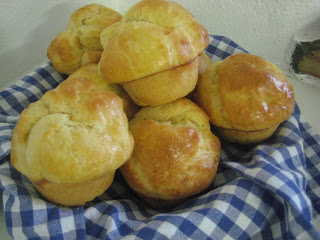
Today was a notorious B.I.G. day. I finished my brioche (which rose last night in the fridge), and then made a loaf of wholemeal bread, vanilla ice cream, mayonnaise, "oeufs mimosa" (sort of like deviled eggs with shrimp), pea soup drizzled with mint cream, and "onion monegasque" (baby onions stewed in a delicious chicken stock base). I also fed my starter (which I started yesterday... I forgot to tell you!). A "starter" is basically a fermented floury paste that, when added to sour dough bread, makes it "sour". You get a large sealed container and stir together 2 ounces of strong baker's flour and 2 fluid ounces of lukewarm water. The next day, add 2 more ounces of flour and 2 more ounces of lukewarm water (this is called "feeding" your starter). Keep feeding daily for seven days (leaving it out overnight at room temperature). By the end of the week, you'll have a bubbling mixture that smells a little bit like beer. There is natural yeast in the baker's flour, in the water, and in the air - so no need to add your own! Sealed in the fridge, a starter will keep indefinitely (the school has one from 2004). This is similar to the technique used by my sister Kate, a master sour dough baker! She got her recipe from Mark Bittman's How to Cook Everything (what a title!).

With pea soup, since it is a green vegetable, remember not to cook it covered! The steam will ruin the color. Also, having it simmering for hours doesn't do much for the color either. If any of you are concerned or worried, rest assured: my cheese is doing fine. He is starting to form an outer rind (they grow up so fast!).

For our afternoon demonstration, Rory taught us how to assemble a top notch plate of smoked fish (the secret? quality smoked fish!), how to cure our own gravlax (salmon "cooked" in salt, sugar, and dill), how to grill the perfect steak (both fillet and sirloin, with various sauces to go with it), and how to make cauliflower gratin, ratatouille (if you haven't seen the movie, do yourself a favor and rent it), pommes allumettes (AKA matchstick potatoes), a Normandy pear tart, and an apricot tart. Let me just say, the tasting line was as long as I have ever seen it! Even our class' resident vegetarian could not resist trying Rory's steak au poivre (I am not making this up).
 Tuesday's Tips:
Tuesday's Tips:- Buy almonds with the skin on. The skin keeps in the flavor. To take the skin off, boil the almonds for a minute in water. They will pop right out of their jackets after this bubbly bath.
- Again, if you can buy "dry aged" meat (as opposed to "wet aged" meat), do so. Ask your butcher! It is much more tender, and has so much more flavor.
- The fillet is the most expensive cut of beef, followed by the sirloin. The flank is the least expensive.
- Score the fat on a roast to encourage it to run out of the meat during cooking. You can do this with a sharp knife or a razor blade. Criss-crossed lines work well.
- Try rubbing steaks with a halved clove of garlic before grilling them. You will not taste the garlic, but it will make them taste more "beefy".
- Grind spices separately (some take longer than others) - this will save your spice grinder (AKA coffee grinder) unnecessary wear and tear.
- Take steaks out of the fridge 30 minutes before cooking them so that they can get closer to room temperature (especially if you are going to cook your steak rare or medium rare).
- Make sure your butter chunks are cold when making Bearnaise or Hollandaise sauce. There is science behind this logic. The whisking and the heat are what emulsifies the sauce. If your butter is warm, the heat from the whisking will practically be enough to emulsify the sauce. This is not what you want. You need the heat from the stove to "cook" the sauce while you whisk. So, add cold butter, and the cold butter + warm whisking + warm stove will both emulsify and "cook" your sauce.
- Get to know what well done vs. rare beef feels like. Take your hand and turn it palm facing up. Relax your hand (a yoga hand, not a death grip). Lightly touch your thumb to your pinky and feel the heel of your thumb. That is what well done meat feels like. Touch your thumb to your pointer finger and feel the heel of your thumb. This is what rare meat feels like. For those of you who know me, the "heel" of your thumb is where my birthmark is (or have you blocked that eye-sore from your memory?)!
- Let steaks sit between 5 and 20 minutes to rest before serving. While you wait, keep them warm in a low oven.
- Smoked mussels are delicious as canape, served on a round of thinly sliced dark brown bread. (maybe lightly toasted with some dill butter!). Don't forget some lemon wedges!
- Bearnaise sauce can be delicious with a pinch of cayenne pepper.
- Tinned apricots work well in an apricot tart when fresh apricots are not in season.

Your growing cheese is identifiable by his rind...hmmmm.....and growing the rind all by himself...hmmm.....out of sight, out of mind...hmmm...sounds like most of my children!
ReplyDeletexoxox, Mom